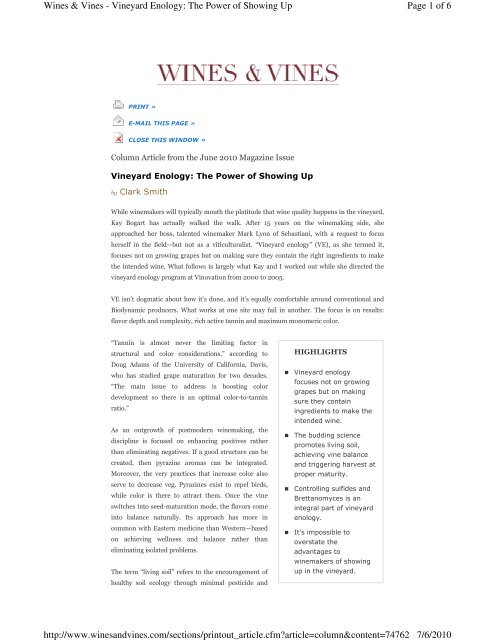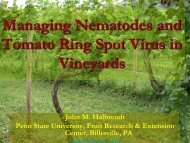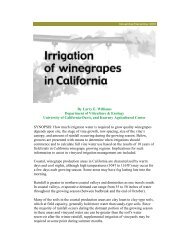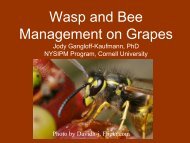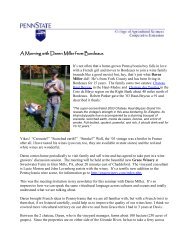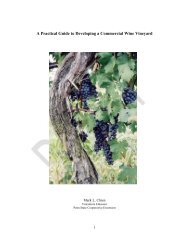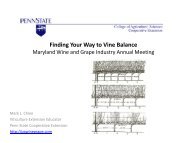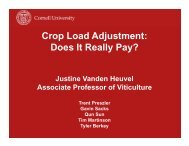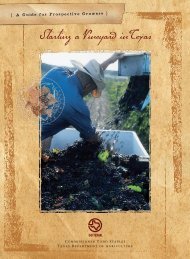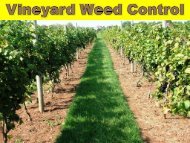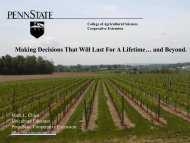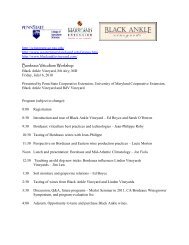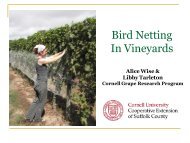Post Modern Winemaking_Clark Smith.pdf - PA Wine Grape ...
Post Modern Winemaking_Clark Smith.pdf - PA Wine Grape ...
Post Modern Winemaking_Clark Smith.pdf - PA Wine Grape ...
You also want an ePaper? Increase the reach of your titles
YUMPU automatically turns print PDFs into web optimized ePapers that Google loves.
<strong>Wine</strong>s & Vines - Vineyard Enology: The Power of Showing Up<br />
http://www.winesandvines.com/sections/printout_article.cfm?article=column&content=74762<br />
Page 1 of 6<br />
7/6/2010<br />
PRINT »<br />
E-MAIL THIS <strong>PA</strong>GE »<br />
CLOSE THIS WINDOW »<br />
Column Article from the June 2010 Magazine Issue<br />
Vineyard Enology: The Power of Showing Up<br />
by <strong>Clark</strong> <strong>Smith</strong><br />
While winemakers will typically mouth the platitude that wine quality happens in the vineyard,<br />
Kay Bogart has actually walked the walk. After 15 years on the winemaking side, she<br />
approached her boss, talented winemaker Mark Lyon of Sebastiani, with a request to focus<br />
herself in the field—but not as a viticulturalist. “Vineyard enology” (VE), as she termed it,<br />
focuses not on growing grapes but on making sure they contain the right ingredients to make<br />
the intended wine. What follows is largely what Kay and I worked out while she directed the<br />
vineyard enology program at Vinovation from 2000 to 2005.<br />
VE isn’t dogmatic about how it’s done, and it’s equally comfortable around conventional and<br />
Biodynamic producers. What works at one site may fail in another. The focus is on results:<br />
flavor depth and complexity, rich active tannin and maximum monomeric color.<br />
“Tannin is almost never the limiting factor in<br />
structural and color considerations,” according to<br />
Doug Adams of the University of California, Davis,<br />
who has studied grape maturation for two decades.<br />
“The main issue to address is boosting color<br />
development so there is an optimal color-to-tannin<br />
ratio.”<br />
As an outgrowth of postmodern winemaking, the<br />
discipline is focused on enhancing positives rather<br />
than eliminating negatives. If a good structure can be<br />
created, then pyrazine aromas can be integrated.<br />
Moreover, the very practices that increase color also<br />
serve to decrease veg. Pyrazines exist to repel birds,<br />
while color is there to attract them. Once the vine<br />
switches into seed-maturation mode, the flavors come<br />
into balance naturally. Its approach has more in<br />
common with Eastern medicine than Western—based<br />
on achieving wellness and balance rather than<br />
eliminating isolated problems.<br />
The term “living soil” refers to the encouragement of<br />
healthy soil ecology through minimal pesticide and<br />
<br />
<br />
<br />
<br />
HIGHLIGHTS<br />
Vineyard enology<br />
focuses not on growing<br />
grapes but on making<br />
sure they contain<br />
ingredients to make the<br />
intended wine.<br />
The budding science<br />
promotes living soil,<br />
achieving vine balance<br />
and triggering harvest at<br />
proper maturity.<br />
Controlling sulfides and<br />
Brettanomyces is an<br />
integral part of vineyard<br />
enology.<br />
It's impossible to<br />
overstate the<br />
advantages to<br />
winemakers of showing<br />
up in the vineyard.
<strong>Wine</strong>s & Vines - Vineyard Enology: The Power of Showing Up<br />
http://www.winesandvines.com/sections/printout_article.cfm?article=column&content=74762<br />
Page 2 of 6<br />
7/6/2010<br />
herbicide use and encouragement of a healthy cover<br />
crop, minimally tilled. It does not necessarily go as far as the extreme and sometimes absurd<br />
practices required for organic certification.<br />
The best indicator that all is well is a healthy earthworm population, which leads to an aerated,<br />
friable soil to prevent concretion and process organic matter to humus rather than glue<br />
formation. Its many advantages include encouraging root depth, canopy control and protection<br />
from hot weather spikes by creating soils that provide both water tension and retention, and are<br />
thus drier in wet years and wetter in dry years. Living soils enhance wine minerality, increasing<br />
palate vibrancy and wine longevity.<br />
Balancing act<br />
Experienced viticulturist Diane Kenworthy of Barricia Vineyards promotes vine balance as the<br />
economic meeting place for winemakers and growers. Notwithstanding the acknowledged<br />
density of some low-yielding vineyards, the myth that low yields result in greater flavor<br />
concentration has little factual support. Drop crop on a vigorous variety with available nutrition<br />
and water, and you’re going to get leaves, shading, vegetal aromas, poor color, berry<br />
enlargement, diluted flavors and increased rot. Vine balance seeks to optimize color by hanging<br />
adequate crop to hold back canopy and obtain flecked sunlight on the fruit.<br />
An important aspect of light exposure is the formation of quercetin, a UV blocker grapes use<br />
like suntan oil. Quercetin is formed in response to sun on the fruit early in the season postbloom,<br />
and it has another important use in winemaking. Pigment molecules are not very<br />
soluble, and they need to form colloids in order to be extracted into fermenting must.<br />
Unfortunately, they are also positively charged and repel each other, and thus cannot form into<br />
colloids by themselves, but need to be insulated by similarly shaped, uncharged phenols.<br />
Quercetin’s unique flat shape makes it a powerful pigment extraction cofactor.<br />
Shoot, Root and Berry Growth Rate Comparison. Click image to enlarge.<br />
A concerted midseason shift in vine dynamics from vegetal growth to fruit maturation is vital to<br />
proper fruit development. The graph above shows the growth phases vines undergo during the<br />
season: first shoots, then roots, then berry cellular division (cycle one), followed by postveraison<br />
fruit enlargement and maturation (cycle two), and lastly a root growth spurt postharvest.
<strong>Wine</strong>s & Vines - Vineyard Enology: The Power of Showing Up<br />
http://www.winesandvines.com/sections/printout_article.cfm?article=column&content=74762<br />
Page 3 of 6<br />
7/6/2010<br />
Shift to Cycle Two. Click image to enlarge.<br />
All of the following vineyard conditions must be present in moderation in relation to soil type:<br />
water availability, incident light, canopy temperature, air movement and nutrient status. For<br />
example, too little sunlight shuts down color and flavor development, but too much causes<br />
sunburn. Too little air movement leads to rot, but too much wind results in stomatal closure<br />
and shutdown of sugar transport. Each of these aspects affects all the others. A shot of fertilizer<br />
results in more canopy, less light, higher temperatures, less air movement and increased soil<br />
water depletion.<br />
In the irrigated vineyards of the American West, the midseason steering wheel for vine balance<br />
is irrigation control. Leaf water potential is a preferred tool for gauging water availability,<br />
because it makes no assumptions about soil water tension and instead simply asks the vine<br />
itself. This technique is equally valuable as a diagnostic tool in unirrigated vineyards in the<br />
American East and in Europe.<br />
To measure LWP, a young leaf is taken at solar noon and placed in a pressure chamber with its<br />
petiole emerging through a gasket. Gas pressure is then applied until a sap bead appears,<br />
duplicating the force with which water is being drawn from the soil. Vines with access to free<br />
water read at minus-10 bars or less.<br />
A reading of minus-12 to minus-14 bars at veraison is desirable in promoting the transition to<br />
cycle two. This is before tendrils and other canopy indicators will show water stress signs,<br />
which set in over minus-14 bars in most cultivars. A reading of minus-17 bars marks the<br />
permanent wilt point and is believed to trigger stomatal closure.<br />
Water tension management has been shown to be most effective prior to veraison. Late-season<br />
water stress has little beneficial effect on color and flavor development, and it can lead to<br />
stressed flavors such as black pepper, and to field oxidation and fruit deterioration.<br />
Marks of maturity
<strong>Wine</strong>s & Vines - Vineyard Enology: The Power of Showing Up<br />
http://www.winesandvines.com/sections/printout_article.cfm?article=column&content=74762<br />
Page 4 of 6<br />
7/6/2010<br />
<strong>Post</strong>modern principles point to some very specific desired characteristics in red musts. Flavor<br />
finesse is achieved through fineness of texture. The smaller the grain size of the colloids that<br />
make up the tannin structure, the greater their combined surface area and thus, the greater<br />
their power to integrate aromas and their stability over time.<br />
These colloids are aggregates of polymerized tannins formed through the oxidative linking of<br />
monomers, much like structures built from Legos (actually a large variety of three-ringed<br />
compounds called flavonoids, which build up in grape skins during the season). The winemaker<br />
can control this polymerization in the cellar if the tannins arrive in the must as individual Legos<br />
rather than the pre-fab polymers, which result from field oxidation.<br />
Oxidative polymerization requires a specific chemical structure on the molecule called a vicinyl<br />
diphenol (see February’s column “Creating the Conditions For Graceful Aging”). These daisy<br />
chains are terminated when a color monomer (anthocyanin) is added to the chain, because it<br />
lacks this feature. Color molecules are the bookends on the polymer; thus, the more color, the<br />
softer and more refined the texture. But this only works if the anthocyanin is a free monomer,<br />
not already fallen victim to field oxidation.<br />
Berries are formed after bloom and set, then first enlarge to pea size while keeping their green<br />
color to camouflage them from birds looking for a meal (cycle one). Once seeds mature, they<br />
enter cycle two and color up. The goal of harvest timing is to catch color development when the<br />
reactive monomer has hit maximum and before it is lost to polymerization—ripe but not<br />
overripe.<br />
An additional consideration is extraction. Since color is extracted from the inside surface of the<br />
skin, it is advisable to wait until the gelatinous pectin begins to break down, as indicated by a<br />
colored “brush” when the pedicel is pulled away from the berry. In addition, co-pigmentation<br />
colloids are destabilized by high alcohol, so high-Brix musts lose much of their color at the end<br />
of fermentation.<br />
Stinky is good<br />
A challenging aspect of the postmodern approach is the proclivity of well-extracted, properly<br />
ripe musts grown in living soils to produce sulfides. While disconcerting to the novice<br />
winemaker, these unpleasant but transitory compounds are a sign of healthy life energy that<br />
can be utilized for building good structure, and also indicate aging potential.<br />
The postmodern winemaker’s response to sulfides will vary according to the wine’s intended<br />
style and aging curve, a topic for another article. Suffice it here to say that the PM toolkit<br />
contains plenty of options for dealing with sulfites, which, unless present in quite gross<br />
amounts, are almost never a real problem. Randall Grahm has likened sulfides to acne: If your<br />
teenage son doesn’t have pimples, he’s less likely to be happily married when he’s 65. He<br />
compared the life energy of young wines and young men with old wines and older men. A wellbehaved<br />
endocrinology in youth has consequences for libido when it wanes. Similarly, wines<br />
that are aromatically closed and/or make a little H2S in youth have more staying power,<br />
generally as a consequence of strong reactive tannins, lees, and/or minerality. Personally, I<br />
used to worry about wines with H2S; now I worry about wines that don’t have it.<br />
Intolerance of reductive behavior in highly concentrated wines like Cabernet and Syrah has<br />
prompted many winemakers to drive the life energy out of their grapes by excessive hang time<br />
and field oxidation. While this certainly results in well-behaved young musts, which require
<strong>Wine</strong>s & Vines - Vineyard Enology: The Power of Showing Up<br />
http://www.winesandvines.com/sections/printout_article.cfm?article=column&content=74762<br />
Page 5 of 6<br />
7/6/2010<br />
little attention and are easily bottled in youth, the practice robs the wines of both longevity and<br />
distinctiveness, leaving pruney wines that taste the same and have little shelf life.<br />
It is unfortunate that so many California winemakers have taken this road that we are now<br />
typecast in the minds of many of the country’s sommeliers as producers of shallow, short-lived<br />
impact wines, and are often not taken as seriously as we once were.<br />
Integrated Brett management<br />
The Integrated Pest Management approach to vineyard ecology encourages beneficial<br />
organisms rather than wiping out pests. At one time considered risky and fairly wacky, IPM is<br />
now a mainstream viticultural system, but most winemakers have yet to translate its philosophy<br />
into the cellar. This bleeding edge practice is known as integrated Brett management (IBM),<br />
which similarly promotes wine microbial balance rather than draconian control.<br />
What compels postmodern winemakers to take this apparently risky approach? The same<br />
reason there are no sterile filters in dairies. It is the rea lization that the physical properties of a<br />
structured food are disrupted by sub-micron filtration. Sterile-filtered milk is no longer milk,<br />
and likewise structured wines lose their powers of aromatic integration, flavor depth and<br />
soulfulness.<br />
Once the decision is made to eschew sterile filtration, care must be taken to encourage whatever<br />
microbiological activity for which the wine is destined. Albert Einstein said, “It is impossible<br />
simultaneously to prevent and prepare for war.” Half measures are hard to countenance,<br />
because the most dangerous situation is to have only partial stability prior to bottling. The three<br />
legs of the IBM stools are nutrient desert, integrative structure and microbial equilibrium.<br />
Creating the conditions for a successful microbial balance starts in the vineyard, with petiolar<br />
nitrogen measurements at bloom. The purpose is to determine hotspots where supplemental<br />
soil fertilization is required in order to obtain a healthy must that does not require DAP<br />
addition to facilitate completion of fermentation. A nutrient desert is created by promoting a<br />
healthy and complete fermentation, not only of sugar, but also with regard to the consumption<br />
of micronutrients. Brett is a fastidious organism that does not pack the genetic baggage to<br />
manufacture many of its essential nutrients. A naturally balanced grape is best, so fermentor<br />
additions such as DAP are not necessary. DAP can cause runaway fermentations that achieve<br />
sugar dryness without consuming micronutrients. If we feed them Twinkies, they won’t eat<br />
their oatmeal.<br />
These aspects of Brett control are an integral part of vineyard enology. Vine balance and proper<br />
harvest maturity encourage healthy, complete fermentations, and careful canopy management<br />
to promote metabolic manufacture and extraction of dense, well-formed structure can integrate<br />
what Brett does occur and render its aromas into positive sensory elements.<br />
An ounce of prevention<br />
Pliny the Elder said, “The best manure is the master’s footsteps.” Kurt Vonnegut said, “90% of<br />
life is just showing up.” It’s impossible to overstate the advantages to winemakers of showing<br />
up in the vineyard. You are constantly coming across things that you didn’t know that you<br />
didn’t know, whether it be a gopher hole, a broken drip head or an insect pressure. It also adds<br />
to your spiritual health: There are no atheists in vineyards. From a pure marketing point of<br />
view, your genuine knowledge of your wine’s source will inform your presentation of it to<br />
customers and enhance your image as the real deal.
<strong>Wine</strong>s & Vines - Vineyard Enology: The Power of Showing Up<br />
http://www.winesandvines.com/sections/printout_article.cfm?article=column&content=74762<br />
Page 6 of 6<br />
7/6/2010<br />
<strong>Clark</strong> <strong>Smith</strong> is winemaker for <strong>Wine</strong><strong>Smith</strong>, founder of the wine technology firm Vinovation.<br />
He lectures widely on an ancient yet innovative view of American winemaking. To comment<br />
on this column, e-mail edit@winesandvines.com.<br />
PRINT »<br />
E-MAIL THIS ARTICLE »<br />
CLOSE THIS WINDOW »<br />
415.453.9700 | Fax: 415.453.2517<br />
info@winesandvines.com


